Old World deer
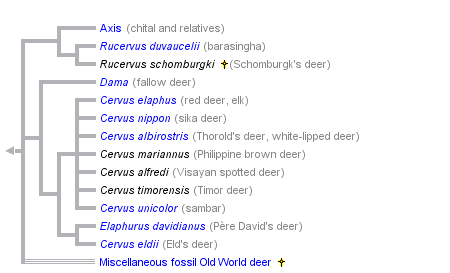


This tree diagram shows the relationships between several groups of organisms.
The root of the current tree connects the organisms featured in this tree to their containing group and the rest of the Tree of Life. The basal branching point in the tree represents the ancestor of the other groups in the tree. This ancestor diversified over time into several descendent subgroups, which are represented as internal nodes and terminal taxa to the right.

You can click on the root to travel down the Tree of Life all the way to the root of all Life, and you can click on the names of descendent subgroups to travel up the Tree of Life all the way to individual species.
For more information on ToL tree formatting, please see Interpreting the Tree or Classification. To learn more about phylogenetic trees, please visit our Phylogenetic Biology pages.
close boxReferences
Di Stefano, G. and C. Petronio. 1998. Origin of and relationships among the Dama-like cervids in Europe. Neues Jahrbuch für Geologie und Palaeontologie Abhandlungen 207:37-55.
Di Stefano, G. and C. Petronio. 2002. Systematics and evolution of the Eurasian Plio-Pleistocene tribe Cervini (Artiodactyla, Mammalia). Geologica Romana 36:311-334.
Emerson, B.C. and M. L. Tate. 1993. Genetic analysis of evolutionary relationships among deer (Subfamily Cervinae). Journal of Heredity 84:266-273.
Fernández, M. H. and E. S. Vrba. 2005. A complete estimate of the phylogenetic relationships in Ruminantia: a dated species-level supertree of the extant ruminants. Biological Reviews 80(2):269-302.
Gilbert, C., A. Ropiquet, and A. Hassanin. 2006. Mitochondrial and nuclear phylogenies of Cervidae (Mammalia, Ruminantia): Systematics, morphology, and biogeography. Molecular Phylogenetics and Evolution 40(1):101-117.
Liu, X.-H., Y.-Q. Wang, Z.-Q. Liu, and K.-Y. Zhou. 2003. Phylogenetic relationships of Cervinae based on sequence of mitochondrial cytochrome b gene. Zoological Research 24:27-33.
Ludt, C. J., W. Schroeder, O. Rottmann, and R. Kuehn. 2004. Mitochondrial DNA phylogeography of red deer (Cervus elaphus). Molecular Phylogenetic and Evolution 31(3):1064-1083.
Meijaard, E. and C. P. Groves. 2004. Morphometrical relationships between South-east Asian deer (Cervidae, tribe Cervini): evolutionary and biogeographic implications. J. Zool. Lond. 263:179–196.
Pitra, C. J. Fickel, E. Meijaard and P. C. Groves. 2004. Evolution and phylogeny of old world deer. Molecular Phylogenetics and Evolution 33:880–895.
Polziehn, R. O. and C. Strobeck. 1998. Phylogeny of wapiti, red deer, sika deer, and other North American cervids as determined from mitochondrial DNA. Molecular Phylogenetics and Evolution 10:249-258.
Polziehn, R. O. and C. Strobeck. 2002. A phylogenetic comparison of red deer and wapiti using mitochondrial DNA. Molecular Phylogenetics and Evolution 22:342-356.
Randi, E., N. Mucci, F. Claro-Hergueta, A. Bonnet, and E. J. P. Douzery. 2001. A mitochondrial DNA control region phylogeny of the Cervinae: speciation in Cervus and implications for conservation. Animal Conservation 4:1-11.
Randi, E., N. Mucci, M. Pierpaoli, and E. Douzery. 1998. New phylogenetic perspectives on the Cervidae (Artiodactyla) are provided by the mitochondrial cytochrome b gene. Proceedings of the Royal Society of London Series B 265:793-801.
Title Illustrations

| Scientific Name | Rucervus duvaucelii |
|---|---|
| Location | Madhya Pradesh, India |
| Specimen Condition | Live Specimen |
| Source | Barasinga |
| Source Collection | Flickr |
| Image Use |
 This media file is licensed under the Creative Commons Attribution-NonCommercial-NoDerivs License - Version 2.0. This media file is licensed under the Creative Commons Attribution-NonCommercial-NoDerivs License - Version 2.0.
|
| Copyright | © 2007 Jayanth Sharma |
| Scientific Name | Dama dama |
|---|---|
| Location | Kent, England, UK |
| Specimen Condition | Live Specimen |
| Source | Fallow deer |
| Source Collection | Flickr |
| Image Use |
 This media file is licensed under the Creative Commons Attribution-NonCommercial-ShareAlike License - Version 2.0. This media file is licensed under the Creative Commons Attribution-NonCommercial-ShareAlike License - Version 2.0.
|
| Copyright | © 2007 Linda Cronin |
| Scientific Name | Axis axis |
|---|---|
| Location | Ranthambhore National Park, Rajasthan, India |
| Specimen Condition | Live Specimen |
| Source | I decided long ago never to look at the right hand of the menu or the price tag of clothes -- otherwise I would starve, naked. |
| Source Collection | Flickr |
| Image Use |
 This media file is licensed under the Creative Commons Attribution-NonCommercial License - Version 2.0. This media file is licensed under the Creative Commons Attribution-NonCommercial License - Version 2.0.
|
| Copyright | © 2007 g. dan hutcheson |
| Scientific Name | Cervus elaphus |
|---|---|
| Location | Highland Wildlife Park, Kincraig, Scotland |
| Specimen Condition | Live Specimen |
| Sex | Male |
| Source | If you're lying around enjoying the sun, you're not executing; you're just another sitting target. |
| Source Collection | Flickr |
| Image Use |
 This media file is licensed under the Creative Commons Attribution-NonCommercial License - Version 2.0. This media file is licensed under the Creative Commons Attribution-NonCommercial License - Version 2.0.
|
| Copyright | © 2007 g. dan hutcheson |
About This Page
Page copyright © 2007
 Page: Tree of Life
Old World deer.
The TEXT of this page is licensed under the
Creative Commons Attribution-NonCommercial License - Version 3.0. Note that images and other media
featured on this page are each governed by their own license, and they may or may not be available
for reuse. Click on an image or a media link to access the media data window, which provides the
relevant licensing information. For the general terms and conditions of ToL material reuse and
redistribution, please see the Tree of Life Copyright
Policies.
Page: Tree of Life
Old World deer.
The TEXT of this page is licensed under the
Creative Commons Attribution-NonCommercial License - Version 3.0. Note that images and other media
featured on this page are each governed by their own license, and they may or may not be available
for reuse. Click on an image or a media link to access the media data window, which provides the
relevant licensing information. For the general terms and conditions of ToL material reuse and
redistribution, please see the Tree of Life Copyright
Policies.
- First online 05 July 2007
- Content changed 05 July 2007
Citing this page:
Tree of Life Web Project. 2007. Old World deer. Version 05 July 2007 (temporary). http://tolweb.org/Old_World_deer/51168/2007.07.05 in The Tree of Life Web Project, http://tolweb.org/




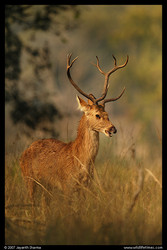
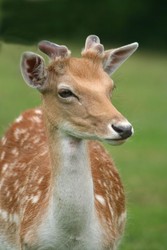
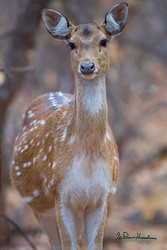
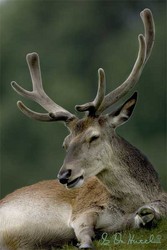





 Go to quick links
Go to quick search
Go to navigation for this section of the ToL site
Go to detailed links for the ToL site
Go to quick links
Go to quick search
Go to navigation for this section of the ToL site
Go to detailed links for the ToL site